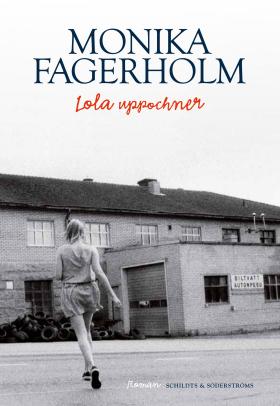
Lola uppochner
(Lola Upside-Down)
by Monika Fagerholm
reviewed by Darcy Hurford
Ever since Wonderful Women by Water made her name, Monika Fagerholm, one of Finland’s foremost Swedish-speaking authors, has practically created a genre of her own. ‘Fagerholmism’ is characterised by female narrative voices, by melancholy and an eye for detail, and by peripheral settings, whether that means the suburbs (Diva), coastal holiday-home areas out of season (The American Girl, The Glitter Scene) or, in Lola uppochner, small-town life, represented by the fictional town of Flatnäs. The most striking feature of Fagerholm’s writing, however, is its language, the way that sentences twist and turn on themselves, and Lola uppochner is no exception. Reviewing the novel in the Swedishlanguage daily Hufvudstadsbladet, Michel Ekman noted that Fagerholm does not tell a story as much as evoke a world.
While there is a resemblance between the Flatnäs of the novel and the reallife Ekenäs (Tammisaari in Finnish) where Fagerholm lives, it could almost be any small town anywhere. In Flatnäs, everyone knows everyone else, and the poorer people live in Skitviken, while the villas in the nice part of town are for the better class of person. Fleming Pettersson, whose murder is the central event of the novel, was a villa-dweller. Jana Marton, who finds the body, is not. The novel opens with Jana, now an adult, returning to the town she left as a teenager to attend a dinner party ‘for the girls’ thrown by Minnie Pettersson, wife of Fleming’s cousin; it closes with the dinner party and its outcome. In between these two events, set in 2011, the story goes back in time to 1994, the year the Estonia ferry sank and the year in which Fleming was murdered. An array of characters and sub-plots are brought to life on the page only to swiftly disappear again, like images seen in a kaleidoscope; the novel begins with a two-page cast list, rather like the Russian classic novels did, and readers will find it useful. A world is evoked, both chaotic and gripping. The presence of the talking doll, Lola Upside-Down, links the scenes.
Initially, Lola uppochner appears to be a detective story but it quickly shifts register and becomes something more elusive. Monika Fagerholm has stated that the TV series Twin Peaks was an influence on the novel, and there are many similarities: like Laura Palmer, Fleming Pettersson is one of the town’s gilded youth, and his death uncovers its less pleasant sides. At the same time, there is an element of comedy. The police force of Flatnäs consists of Big Berglund and Little Berglund, twin brothers whose police activity seems mainly to involve drinking coffee, eating doughnuts and wearing tinted sunglasses – more Kling and Klang from Pippi Longstocking than Agent Dale Cooper, as Mia Österlund has commented.
The Bäck family, meanwhile, exists in exaggerated, almost Victorian pathos. They live in a windmill designed by the stepfather Ib Kavanaugh, a poet with bipolar disorder. While the daughters Anita and Ca are still teenagers, Ib leaps from the top floor of the Stockmann department store in Helsinki, in the belief that he can fly. From then on, the Bäck family’s life turns Gothic in its misery. Mother retreats into alcoholism, Ca into the arms of older men, and Anita, who suffers from a degenerative wasting disease, is left bitterly alone, rattling around the windmill.
The novel ends on a similarly exaggerated note. Without giving too much away, Fagerholm uses no less than three traditional denouement scenes – the unexpected confession, the gathering, the violent confrontation – to reveal who the killer was. The final twist in the plot is matched by the final genre twist – this time into parody.
A translated extract from the novel appears in the SBR special issue Cool Swedish Titles from Finland. A longer English translation is available from the agent (Leyla Belle Drake, Salomonsson Agency)

Lola uppochner
Schildts & Söderströms, 2012. 461 pages.
